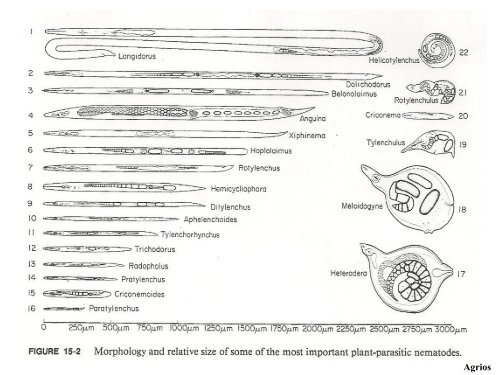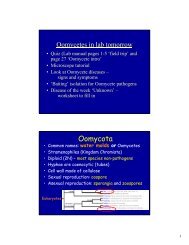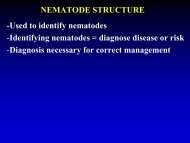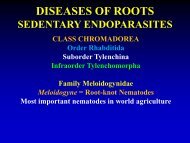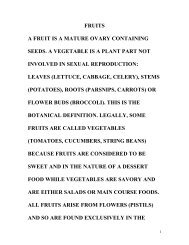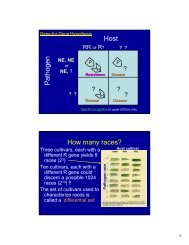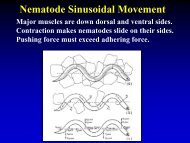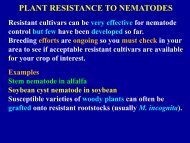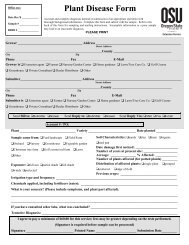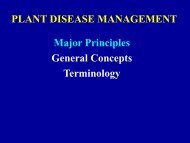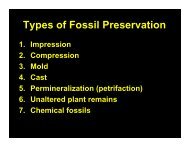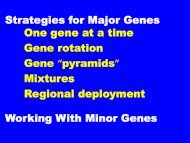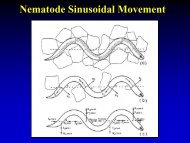DISEASES OF FLOWERS, LEAVES AND STEMS
DISEASES OF FLOWERS, LEAVES AND STEMS
DISEASES OF FLOWERS, LEAVES AND STEMS
You also want an ePaper? Increase the reach of your titles
YUMPU automatically turns print PDFs into web optimized ePapers that Google loves.
Anguina tritici - wheat seed gall nematode- J2 emerge from egg when conditions are right forseed germination, J2 is infective stage- Anguina tritici may have 40+ adults/gall- Other species may have only 1 male and 1 female/gall- Adults die soon after eggs are laid, may not berecognizable in gallJ.D. EisenbackNemapix 1
Anguina tritici - wheat seed gall nematode- Worldwide in distribution- Of minimal importance in countries with "modern"mechanized agriculture but can be very seriousin developing countries.- Not seen in US in decades, found in Mexico near US- Yield losses can approach 70%- Today it is important in India, eastern Europe,the middle east, and parts of Africa.
Anguina tritici – wheat seed gall nematode- One female may lay as many as 2,000 eggs- Anguina tritici may have 30,000 eggs in a single gall- Galls are weakly attached and fall to the groundduring harvest to continue infestation- Galls harvested with seed may be inadvertentlysown with seed to infest new fields- Eggs and J2 will be quiescent or cryptobiotic andover-winter in the gallcan be revived after 30 years if kept dry- One generation a year, so populations build upslowly in soil- Nematode may interact with pathogenic bacteria toproduce other conditions we will discuss later
Anguina triticiJ2 from abroken seedgallplpnemweb.ucdavis.edu/nemaplex
Anguina tritici - wheat seed gall nematodeGalls are distinct from wheat seed, galls are similar inappearance to smut but smutted seeds may still be viableand do not contain nematodes. Galls are not viable.U. ZunkeNemapix 1
Anguina tritici = wheat seed gall nematode - Con- Normal seed can be easily separated from galls bymechanical separator so you can start with "clean" seed.- Galls or "cockles" or "peppercorns" are smaller andfall through mesh.-Seed immersed in brine solution - cockles float and canbe skimmed off. Must be quick.- Done on small scale on farms in developing countries.- Relatively host specific = crop rotation effective.- Volunteer plants and weed hosts must be eliminated.
H. JensenAnguina agrostis - grass seed gall nematode- Galls (about half) fall to ground with straw at harvest.- Was controlled by field burning.- No longer a common practice.One year causedover 100,000 poundsof Oregon grass seedto be rejected.Nematodes frombroken grass seed gall
Anguina agrostis - grass seed gall nematodeSeed cleaning difficult.Galls are a bit smaller thanseed but when covered bylemma and palea they aresimilar in dimension andweight to healthy seed oforchardgrass.Cleaning removes 30% ofhealthy seed as well.Anguina funestra – annualryegrass in AustraliaNormal SeedGallsH. Jensen?
Anguina agrostis – leaf galls on Poa annuaU.C. Nematology
<strong>DISEASES</strong> <strong>OF</strong> <strong>FLOWERS</strong>,<strong>LEAVES</strong> <strong>AND</strong> <strong>STEMS</strong>CLASS CHROMADOREAOrder RhabditidaSuborder TylenchinaInfraorder TylenchomorphaFamily AnguindaeAnguina spp. - leaf and seed gall nematodesDitylenchus dipsaci - stem and bulb nematodeDitylenchus destructor – potato rot nematodeDitylenchus angustus – ufra nematodeDitylenchus myceliophagus
Ditylenchus dipsaci – stem and bulb nematodeQuader & NambiarU. ZunkeNemapix 1
Ditylenchus dipsaci – stem and bulb nematodeJ4 is infectiveMolt soon afterfeeding to adultMigrate intercellularlyor crawl on outsideLay 200-500 eggsMales necessaryEgg-egg19-25 daysat 15 CJ2 & J3molts to J4occur quicklyEggs HatchJ4 leave unfavorable tissuesSeveral generations/seasonNumbers increase quickly
Ditylenchus dipsaci – stem and bulb nematodeInvade near root tipof germinating seed.Epidermis may split.Allows secondary invasionby bacteria and fungi.
Ditylenchus dipsaci – stem and bulb nematodeAs a species attacks 450+ species of plants.Symptoms vary by plant.Produces pectinases = tissue destruction.Produces auxins which causeHyperplasia = increase in cell numberHypertrophy = increase in cell sizeResults in swollen and spongy tissues
Ditylenchus dipsaci – stem and bulb nematodeStem SymptomsExample = alfalfa- Twisted leaves- Thick stems- Short internodes- Lesions in cortex as cellsdestroyed by pectinaseC.W. Laughlin
Ditylenchus dipsaci – stem and bulb nematode“White Flagging” = severely chlorotic stems and leaves
Ditylenchus dipsaci – stem and bulb nematode-Stunted plants overgrown by neighboring plants.-May hide infested plants.-Infestation spreads, canopy opens.-Weeds invade, outcompete weakened plants.-Field may be wiped out in 2-3 years.-Spreads rapidly by water moving infested tissues.
Ditylenchus dipsaci – stem and bulb nematodeBulb Symptoms“Onion Bloat”Tissues separate easily.Bulb may be largerbut not heavier.Individual scales rot.= brown rings.C.W. Laughlin
Ditylenchus dipsaci – stem and bulb nematodeInfection spreads in field and in storageuntil whole bulb is affected.
Ditylenchus dipsaci – stem and bulb nematodeStem lesions, necking& green petals on tulipAslon can be important CSL, in British flower Crown bulbs like Daffodils, GladiolusSpickels = hard noduleson narcissus leaves
Ditylenchus dipsaci J4 – nematode wool on basal platedefradefra
Ditylenchus dipsaci – stem and bulb nematodeControl-Use nematode-free bulbs or seed.-Treat bulbs with hot water 46 C for 1 houror 5% formaldehyde at 43 C for 4 hoursPractice ended in 2008.- Alternatives = 44.4 C for 3 hrs for nematode wool-Fumigate “seed” with MeBr gas? 24 hours at 24 C.- Rotate with nonhost 2-3 yearscontrol weeds and volunteers.-Resistant cultivars: peas, alfalfa, narcissus, oats, rye.-Soil fumigation effective, expensive.Still must use clean planting stock- Vydate applied in-furrow & banded during the season
<strong>DISEASES</strong> <strong>OF</strong> <strong>FLOWERS</strong>,<strong>LEAVES</strong> <strong>AND</strong> <strong>STEMS</strong>CLASS CHROMADOREAOrder RhabditidaSuborder TylenchinaInfraorder TylenchomorphaFamily AnguindaeAnguina spp. - leaf and seed gall nematodesDitylenchus dipsaci - stem and bulb nematodeDitylenchus destructor – potato rot nematodeDitylenchus angustus – ufra nematodeDitylenchus myceliophagus
Ditylenchus destructor – potato rot nematode-Belowground pathogen, discussed with other Ditylenchus-Enters potato tubers through lenticels.-Small white spots developjust below surface.As nematodes multiply,infested areas coalesce intolesions of dry granular tissue.See Invasive Species Compendiumat CABI.org/iscfor more informationBonsak Hammeraas, Bioforsk - Norwegian Institute forAgricultural and Environmental Research, Bugwood.org
Ditylenchus destructor – potato rot nematode-Secondary invasion by other organisms causes a darkbrown rot resulting from rapid tissue breakdown.-Nematodes migrate ahead of tissue breakdown.-Infection continues instorage, spreads to adjacenttubers.Control with certified seed.Wide host range and abilityof nematode to feed on fungimake control difficult.Red PotatoRarely seen in US.Problem in eastern EuropeS. Ayoub
<strong>DISEASES</strong> <strong>OF</strong> <strong>FLOWERS</strong>,<strong>LEAVES</strong> <strong>AND</strong> <strong>STEMS</strong>CLASS CHROMADOREAOrder RhabditidaSuborder TylenchinaInfraorder TylenchomorphaFamily AnguindaeAnguina spp. - leaf and seed gall nematodesDitylenchus dipsaci - stem and bulb nematodeDitylenchus destructor – potato rot nematodeDitylenchus angustus – ufra nematodeDitylenchus myceliophagus
Ditylenchus angustus – ufra nematode- Causes disease in rice called "ufra", "dak pora".- Feeds as migratory ectoparasite on growing, tendertissues and destroys developing leaves and flowers.- Leaves become discolored and malformed.White patches on thegrowing leaf bases ofrice, the initialsymptoms of ‘ufra’disease.Bridge and Starr
Ditylenchus angustus – ufra nematode- Panicles are twisted or fail to emerge from sheath.- Symptoms only present during rainy season rotation.- Floodwaters spread nematodes over large areas.Twisted, distorted,and panicles empty ofmature rice due toinfection byDitylenchus angustusBridge and Starr
Ditylenchus angustus – ufra nematodePrimary infestation comes from residues of precedingcrops but secondary infestations spread from plant toplant in flood water during the growing season.Populations appear to decline rapidly between crops.Control may be partially achieved by prolonging theperiod between crops by1) planting cutivars that mature early2) planting late or3) transplanting during initial flood period.
Large brown patch of dead rice plants, field symptomsof ‘ufra’ caused by Ditylenchus angustus, BangladeshBridge and Starr
<strong>DISEASES</strong> <strong>OF</strong> <strong>FLOWERS</strong>,<strong>LEAVES</strong> <strong>AND</strong> <strong>STEMS</strong>CLASS CHROMADOREAOrder RhabditidaSuborder TylenchinaInfraorder TylenchomorphaFamily AnguindaeAnguina spp. - leaf and seed gall nematodesDitylenchus dipsaci - stem and bulb nematodeDitylenchus destructor – potato rot nematodeDitylenchus angustus – ufra nematodeDitylenchus myceliophagus
Ditylenchus myceliophagus- Destroys mushroom mycelium and depresses yield.- Very large populations aggregate into "clumps"which are resistant to drying and can be carried toother mushroom beds by insects.Control- Decontaminate beds by heating compost and“benches” to kill nematodes.- Sanitation and insect control is essential.
<strong>DISEASES</strong> <strong>OF</strong> <strong>FLOWERS</strong>,<strong>LEAVES</strong> <strong>AND</strong> <strong>STEMS</strong>CLASS CHROMADOREAOrder RhabditidaSuborder TylenchinaInfraorder TylenchomorphaFamily AphelenchoididaeAphelenchoides – “foliar” nematodes-Diverse genus, not all are plant parasites.-Some feed on fungi, including mycorrhizae, insteadof or in addition to plants. Some parasitize insects.-Often interact with bacteria or fungi\disease complexes.
Aphelenchoides ritzemabosi – chrysanthemum leaf nematodeEctoparasite on budsEndoparasite in leavesLay 25-30 eggsEgg-egg 14 days10 generationsper yearBecome activein springOver wintersas adultFoliar NematodeNo time needed in soil!
Aphelenchoides ritzemabosi – chrysanthemum leaf nematodeU. ZunkeNemapix 1U.C. DavisNemaplex
Aphelenchoides ritzemabosi – chrysanthemum leaf nematode- Secretions from nematode can cause:1. Shortening of the internodes which results in abushy appearance of the plant2. Browning3. Failure of shoot to grow (= blindness)4. Production of low, premature side shoots5. Development of distorted leaves.- Damaged buds and petioles and leaves fromdamaged buds develop brown "scars" from groupsof cells killed by the nematodes.- Leaves are malformed and small.
Aphelenchoides ritzemabosi – chrysanthemum leaf nematodeH.M. DarlingInitially cells of vein sheathblock extension of leafnecrosis across veins but inadvanced stages of infectionnecrosis spreads acrossentire leaf, leaves shrink,cling to stem for a time andfall to the ground.-Defoliation proceeds fromlower to upper leaves.-Dieback in lily dramatic &quick = “witches broom”
Aphelenchoides ritzemabosi – chrysanthemum leaf nematode“Blossom Blasting” in Easter LilyCaused by abortion & distortion of flower bud primordiaH. Jensen
Aphelenchoides ritzemabosi – chrysanthemum leaf nematode“Bunchy Top” in Easter LilyCaused by aborted budsH. Jensen
Aphelenchoides ritzemabosi – chrysanthemum leaf nematodeControl-Strict sanitation.-Keep leaves and stems dry.-Take cuttings from tops of long vigorous branches.-Mulch in spring to cover old leaves and preventnematodes from reaching lower leaves.-Heat treatment of bulb scales for 5 minutes at 50 Cor 30 minutes at 44 C.-In greenhouses, leaves of adjacent plants do not touch-Some varietal resistance available.
University of IllinoisExtension RPD No. 1102
Aphelenchoides ritzemabosi – chrysanthemum leaf nematodeControl(Check labels)-Spray plants with Parathion or Systox= organophosphate insecticidesor oxamyl = systemic carbamate nematicideduring July through September.-Apply thionazin (Zinophos) as a drench twicewith a two-week interval between applications.
Aphelenchoides fragariae – spring crimp nematode- Important parasite of strawberries but also attacksother plants including weeds.- Can be found in combination with A. ritzemabosi- Causes twisting of petioles and leaf blades.- Feeds as an ectoparasite.- Control with soil fumigation, using clean stock,rouging, and strategic use of systemic insecticide/nematicide sprays (abamectin, diazinon).- Some resistant cultivars are available.
Aphelenchoides fragariae – Spring crimp nematodeLeaves emerging from buds infested by foliar nematodes can beseverely distorted (left).J.K. Clark
Aphelenchoides fragariae – Spring crimp nematodeLeaves of infected are reduced and yellow-colored; fruits are reduced or absent;interaction with Rhodococcus fascians to cause cauliflower disease.
Aphelenchoides besseyi – white tip of rice-Survives as preadult (J4) in seed,gets distributed with seed.-When hydrated, nematodes leave seed and migrateto growing point of rice where they are carried upas the rice grows.-Move into inside of leaf sheaths and inner tissuesof developing flowers and lay eggs.- Ectoparasites on tissue surface.- Life cycle takes about 8 days = one of most rapid.
Aphelenchoides besseyi – white tip of riceUpper 2-5 cm of leaveslose chlorophyll andbecome yellow to white,then brown & necrotic.R.D. Riggs
Aphelenchoides besseyi – white tip of riceFlag leaves areshortened and twisted.Inflorescence small, withmany sterile florets
Aphelenchoides besseyi – white tip of rice-Under control in U.S. and Japan.-Important in India and Africa- Use certified seed.- Soak seed 10-15 minutes at 55-61 C.- Use resistant cultivars.- Avoid continuous rice!
Aphelenchoides composticula = parasite of edible mushroom--Transmitted in compost used to culture mushrooms.-Mushrooms are continuously cropped for several weeksso nematode populations can get very high.- Control by sterilizing compost and benches.-Organophosphates are not an option since they killthe mushrooms as well.
Bursaphelenchus xylophilus – pine wilt nematode-Very serious in Japan & of great concern in Europe and the US.-Infects 28 species of pine with different severity.-First identified in US in 1979 in Missouri on dying Austrian pine.-Found in 32 states on pine and some cedar, larch & spruce species.USDA Forest Service - North Central Research StationArchive, USDA Forest Service, Bugwood.org
Bursaphelenchus xylophilus – pine wilt nematodeA.C.A.C.PenasPenasNemapixNemapix11
Vulval flap of female Bursaphelenchus xylophilusA.C. PenasNemapix 1
Bursaphelenchus xylophilus – pine wilt nematodeTransmitted by bark beetles and woodborers.Most notably by the pine sawyer, Monochamus alternatusUGA2131031Bugwood.orgBugwood.org
Bursaphelenchus xylophilus – pine wilt nematodeL.D. Dwinell, USDA ForestService, Bugwood.orgAdult beetles emerge fromdead pines in late spring,carrying large numbers ofnematodes (15,000-230,000)in their tracheae.USDA Forest Service - Region 2 - Rocky Mountain RegionArchive, USDA Forest Service, Bugwood.org
Bursaphelenchus xylophilus – pine wilt nematodeBeetles seek tender tissues in crown and twigs of healthypines. Beetles remove outer bark and nematodes leaveinsect and enter tree at points of injury from the beetle'sfeeding.University of Missouri
Bursaphelenchus xylophilus – pine wilt nematodeNematodes migrate to the resin canals and feed onepithelial cells lining the canals which kills these andsurrounding cells.Y. Mamiya, Bugwood.org
Bursaphelenchus xylophilus – pine wilt nematode-Nematode reproduction is rapid.-1 generation is 5 days in summer.-Populations reach 1,000-10,000/g dry wood tissue.-Nematodes spread throughout the tree from roots totops feeding on nonwoody cells.
Bursaphelenchus xylophilus – pine wilt nematodeIn summer, beetlesoviposit in trees stressedfrom nematode feeding.New nematodes may beintroduced to tree by thebeetle at this time..Larvae tunnel into woodwhere nematodes are.Dauer J4 aggregatearound pupae and enterspiracles of new adults.Lacy L. Hyche, Auburn University, Bugwood.orgLacy L. Hyche, Auburn University, Bugwood.org
Bursaphelenchus xylophilus – pine wilt nematodeA few weeks after nematodes invade, there is a reductionof resin flow at the wounds. This is important to theinsect. In healthy trees, resin traps and kills larvalinsects..Amman et al 1990
Bursaphelenchus xylophilus – pine wilt nematodeDamage due to nematode feeding and the physicalblocking by large numbers of nematodes interferes withwater transport important for transpiration.Sapwood moisturedecreases rapidly.Needles lose intensegreen color andbecome rust colored.H. Jensen
Bursaphelenchus xylophilus – pine wilt nematodeTrees appear to die suddenly.Trees infected in May orJune may be dead in lateAugust to mid-October.Disease is more severe inwarmer latitudes.Cool temperatures preventshigh build up of nematode.Pine trees usually survive.Minnesota vs MissouriUniversity of Missouri
Bursaphelenchus xylophilus – pine wilt nematodeBlue stain fungus (Ceratocystis, Ophilostoma) is alsointroduced to the tree by the beetles. The fungusinvades the dying tree and nematodes feed on it. Thus,there is often blue stain in the wood of nematodeinfected trees.L.D. Dwinell, USDA Forest Service, Bugwood.org
Bursaphelenchus xylophilus – pine wilt nematode- Insect controlControl- Removal of dead and dying trees and replant withnonsusceptible trees.- Both are very difficult in large forested areas.- Valuable trees such as in parks can be injected withthe organophosphate nematicide"fensulfothion"= Dasanit, or abamectin
Bursaphelenchus (= Rhadinaphelenchus) cocophilus– red ring nematode = important parasite of palmsCentral and South America and CaribbeanAdults leave palmPalmfalls overNematodesenter larvaeWeevilsovipositin dying palm**Weevilsoviposit inhealthy palm,depositnematodesOlder leaves wilt,turn yellow
Bursaphelenchus cocophilus – red ring nematodePalm weevil (Rhyncophorus palmarum) is attracted toinfected trees where it becomes heavily contaminatedwith the nematodes. Juveniles enter the insect’s mouthand spiracles or diseased plant tissues containingnematodes stick to the insect.Giblin-Davis
Bursaphelenchus cocophilus – red ring nematode- Infested insects oviposit in the soft internodal tissuesof crowns of healthy palms.- Nematodes in or on insects enter trees through cracksin the stem at leaf bases.- Nematodes can also move in soil from infected rootsto those of adjacent healthy trees but this rate ofspread is much slower.- Only trees between 18 months and 20 years of ageappear to be susceptible.- Nematodes multiply rapidly in palms (life cycle is10 days) and enormous numbers invade all parts ofthe plant from cortical tissues of roots to intercellularspaces of stems and trunks.
Bursaphelenchus cocophilus – red ring nematodeA band of necrotic tissue appears in the lower stemsabout 2.5 cm beneath the surface and about 3 cm wide.The death of cells results in a reddish to reddishorangecolor. Thus, the name "red ring disease".W.F. Mai
Bursaphelenchus cocophilus – red ring nematodeThe infection causes occlusionof xylem vessels, water uptakeis restricted, leaves becomeyellow, then brown.
Bursaphelenchus cocophilus – red ring nematodeTrees die in only 3-4 months after initial symptoms appear.Giblin-Davis et al
Bursaphelenchus cocophilus – red ring nematodeControl- Insect control, sprays, traps with diseased coconuttissue treated with fast acting insecticide.- Removal of infected trees = cut and burn!- Use arsenic to kill infected trees.
UNUSED SLIDES
Bursaphelenchus xylophilus – pine wilt nematodeTransmitted by bark beetles and woodborers.Most notably by the pine sawyer, Monochamus alternatus
<strong>DISEASES</strong> <strong>OF</strong> <strong>FLOWERS</strong>,<strong>LEAVES</strong> <strong>AND</strong> <strong>STEMS</strong>CLASS CHROMADOREAOrder RhabditidaSuborder TylenchinaInfraorder TylenchomorphaFamily AnguindaeAnguina spp. - leaf and seed gall nematodesDitylenchus dipsaci - stem and bulb nematodeDitylenchus destructor – potato rot nematodeDitylenchus angustus – ufra nematodeDitylenchus myceliophagus
The superfamily Aphelenchoidea is a large group of stylet-bearingnematodes that have adapted to a wide range of ecologicalrelationships including phytoparasitism, predation, fungus feeding,both in soil and in association with insects, and obligate insectparasitism. The Aphelenchoides genus comprises at least 138 validspecies and is considered in need of a major revision (Cuc et al.,2007). Increases in nematode biodiversity may result from geneticisolation or breaks in homeostasis caused by ecological associationswith other hosts as a consequence of association by descent. Theseassociations have the potential to become isolating mechanisms forspeciation, raising the possibility that the species diversity of plantsand animals can directly affect associated nematode species diversity(Giblin-Davis et al., 2004).From Fan-Yu Jen at al JON 2011?


